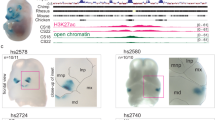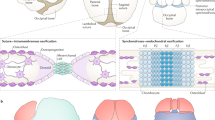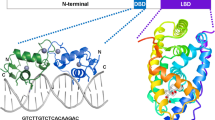Abstract
VARIOUS inbred strains of mice exhibit different degrees of susceptibility to both spontaneous and glucocorticoid-induced cleft palate1,2, and specific genetic and biochemical factors that may be responsible for these differences have been identified. At the genetic level, variations at the H–2 locus have been associated with susceptibility to glucocorticoid-induced cleft palate3,4, while at the biochemical level, evidence suggests that numbers and characteristics of glucocorticoid receptors in murine embryonic facial mesenchyme cells differ in the various strains. Specifically, Salomon and Pratt showed that facial mesenchyme cells cultured from fetuses of the A/J strain (which is highly susceptible to glucocorticoid-induced cleft palate) contain twice as many glucocorticoid receptors as do such cells from C57BL/6J, a low susceptibility strain5. They also reported that the glucocorticoid receptor of the A/J strain has a lower affinity for dexamethasone (KD = 1.7 × 10−8 M) than does that of the C57BL/6J strain (KD = 7.9 × 10−9M) (ref. 5). In an attempt to relate steroid receptor activity to H–2 haplotype, Goldman et al. used 3H-cortisol and isoelectric focusing to study glucocorticoid receptors in facial mesenchyme cells of these and several other strains6. They concluded that “a product of a gene in or near the H–2 locus seems to be the glucocorticoid receptor, the level of which must be increased for a congenital malformation to occur”. Such conclusions must be questioned, however, because the experimental procedure required microelectrofocusing of isolated protein–cortisol complex for 40 h. Receptor binding is reversible, and in the absence of free steroid, the half life of the receptor–cortisol complex is only about 1 h at 0 °C (ref. 7). It is unlikely that a peak of radioactivity detected by isoelectric focusing after 40 h represents binding to a specific receptor. Thus an association between H–2 haplotype and glucocorticoid receptor activity has not been established definitively. However, the possibility that H–2 might determine hormone receptor levels or characteristics is exciting. We have explored the relationship between H–2 and glucocorticoid receptors by examining the level of specific glucocorticoid-binding activity in liver cytosols prepared from different mouse strains.
This is a preview of subscription content, access via your institution
Access options
Subscribe to this journal
Receive 51 print issues and online access
$199.00 per year
only $3.90 per issue
Buy this article
- Purchase on Springer Link
- Instant access to full article PDF
Prices may be subject to local taxes which are calculated during checkout
Similar content being viewed by others
References
Baxter, H. & Fraser, F. C. McGill Med. J. 19, 245–249 (1950).
Shah, R. M. & Travill, A. A. Teratology 13, 71–84 (1976).
Bonner, J. J. & Slavkin, H. C. Immunogenetics 2, 213–218 (1975).
Biddle, F. G. & Fraser, F. C. Genetics 85, 289–302 (1977).
Salomon, D. S. & Pratt, R. M. Nature 264, 174–177 (1976).
Goldman, A. S., Katsumata, M., Yaffe, S. J. & Gasser, D. L. Nature 265, 643–645 (1977).
Pratt, W. B., Kaine, J. L. & Pratt, D. V. J. biol. Chem. 250, 4584–4591 (1975).
Granberg, J. P. & Ballard, P. L. Endocrinology 100, 1160–1168 (1977).
Nielsen, C. J., Vogel, W. M. & Pratt, W. B. Cancer Res. 37, 3420–3426 (1977).
Edidin, M. in Transplantation Antigens (eds Kahan, B. D. & Reisfeld, R. A.) 128 (Academic, New York, 1972).
Bell, P. A. & Munck, A. Biochem. J. 136, 97–107 (1973).
Nielsen, C. J., Sando, J. J. & Pratt, W. B. Proc. natn. Acad. Sci. U.S.A. 74, 1398–1402 (1977).
Nielsen, C. J., Sando, J. J., Vogel, W. M. & Pratt, W. B. J. biol. Chem. 252, 7568–7578 (1977).
Sando, J. J., Nielsen, C. J. & Pratt, W. B. J. biol. Chem. 252, 7579–7582 (1977).
Author information
Authors and Affiliations
Rights and permissions
About this article
Cite this article
BUTLEY, M., ERICKSON, R. & PRATT, W. Hepatic glucocorticoid receptors and the H–2 locus. Nature 275, 136–138 (1978). https://doi.org/10.1038/275136a0
Received:
Accepted:
Published:
Issue Date:
DOI: https://doi.org/10.1038/275136a0
This article is cited by
-
Glucocorticoid receptors and inhibition of neonatal mouse dermal fibroblast growth in primary culture
Archives of Dermatological Research (1980)
Comments
By submitting a comment you agree to abide by our Terms and Community Guidelines. If you find something abusive or that does not comply with our terms or guidelines please flag it as inappropriate.



